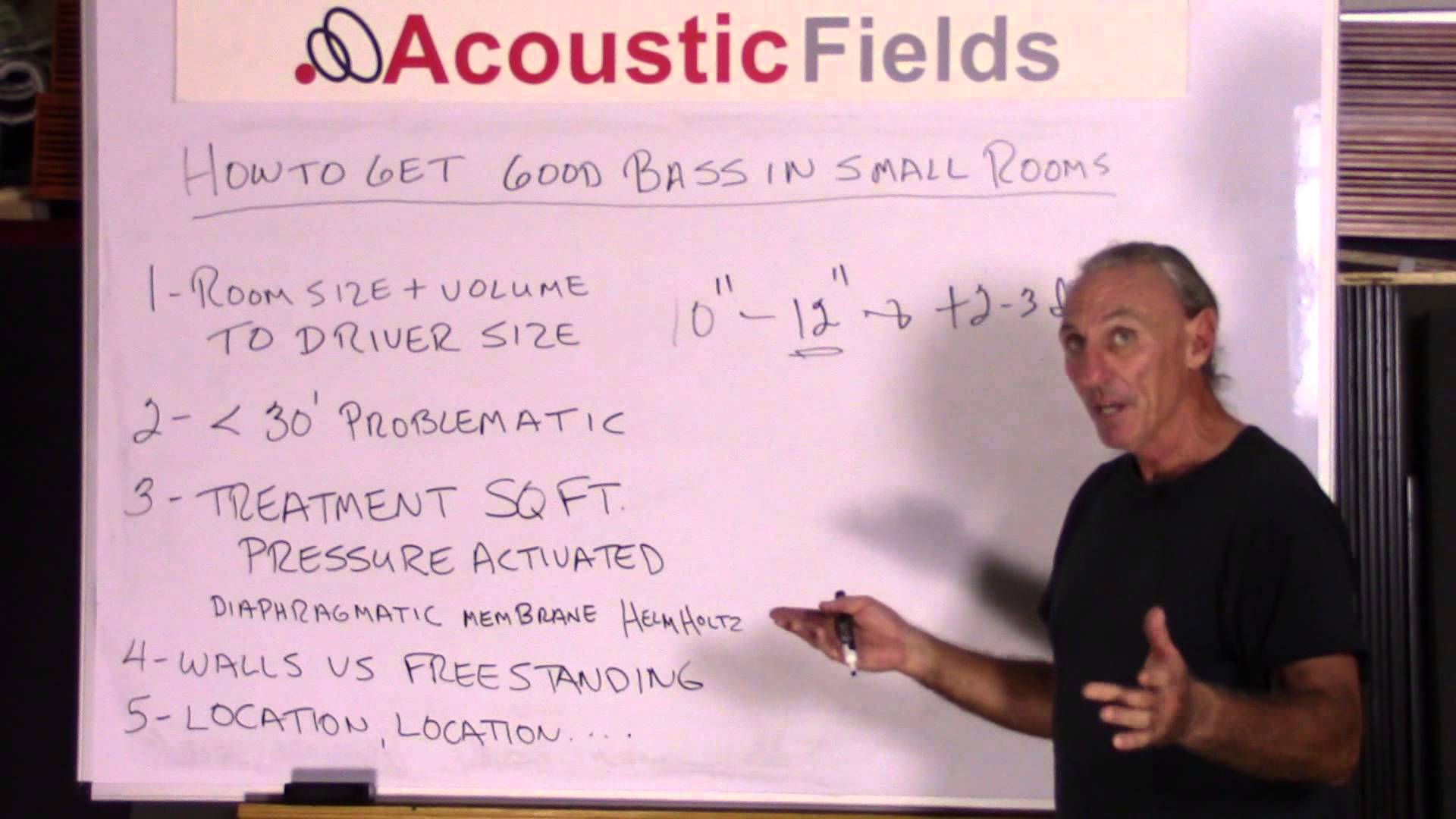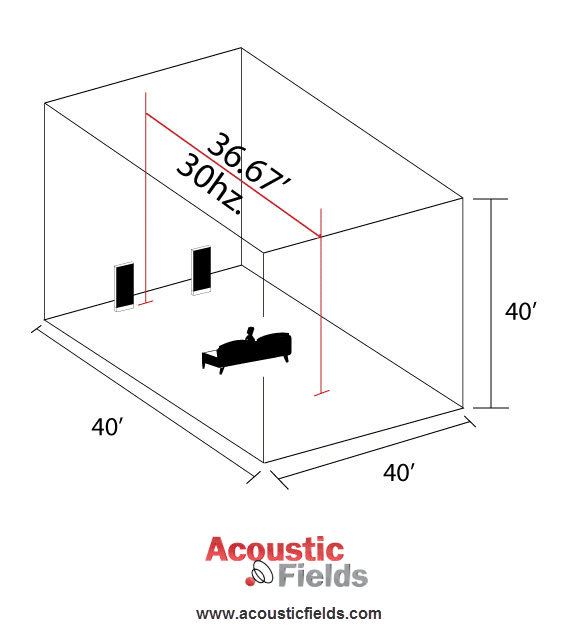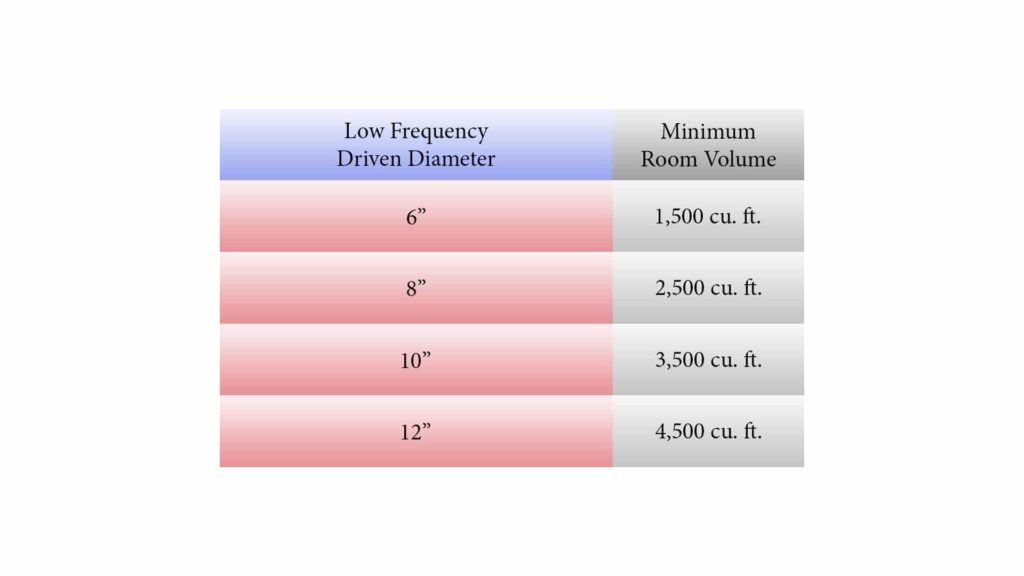Today we’re going to talk about how to get good bass in small rooms. Good bass usually is a thing that happens in larger rooms but obviously real estate’s expensive and we all have to be relegated, if you will, to a smaller volume and space requirements. So how do we get good bass in small rooms? First thing we have to look at is room size and volume.
Room Size & Volume
Room size, the dimensions of the room, the width, the length, the height all create opportunities for low-frequency wavelengths that are thirty, forty, fifty foot long, not to fit. So we want to minimize the way they don’t fit and we do that through selecting the proper length, the proper width and the proper height.
Now that said thirty foot is proper but we don’t get that today. Real estate’s just too expensive so most of us can’t have 30 feet in one dimension let alone two dimensions. So we have to realize that that’s the ideal situation and work down from there.
So matching the size of the driver to the size of the room that we have to deal with is also very important because we don’t want to put too much energy in a room that doesn’t have the volume to handle it. We don’t want to put too little of energy in a room that has so much volume that it can handle it. Both are opposite ends of an extreme that we don’t want.
So we want to match the driver size to the room volume. A ten-inch driver versus a twelve-inch driver can add up to two to three dB more energy just because it’s two inches bigger. So it’s twenty percent larger but it gets us another two to three dB in energy. Now you say that might not sound like a lot in middle and high frequencies, and probably isn’t. but when you get to low frequency and it’s plus two, plus three dB of energy more, you just exasperate the problems that are already in the room and you may become much larger than they really are. So a good match is there.
The following graphic are some practical guide numbers to help you to match your low frequency drivers diameter to your room size and volume. This is based on our 8 year R&D project building, testing and measuring different room sizes and construction techniques.
Selecting The Appropriate Room Treatment Is Key
With treatment you have to realize that your room is not going to be ideal unless it falls into that thirty-foot dimensional issue we previously discussed. So treatment is critical and it needs to be the right type and the right amount. You have to have type and amount as those two things are critical.
So you have to remember that the pressure produced by subwoofers, that give us the good bass in small rooms is a pressure activated situation and there’s only three treatments that will work for that:
1. Diaphragmatic,
2. Membrane and
3. Helmholtz.
So you can take that technology, you can build freestanding units, lots of them or if you’re in the build phase you can build that technology into the wall itself and not have any freestanding units around. You build it into the walls you’re able to match the absorption technology with the area of the room that has that particular frequency modal pressure issue.
So you can go out through the whole room and really wrap the room in low-frequency absorption technology which will give you a lot of definition, attack and decay in your room. We actually use activated carbon and incorporate our diaphragmatic absorption technology in the wall. You can read about that here.
Location Is Critical
Location, location, location! Each room depending on its dimensions and volume has certain room modal issues at certain places. When you use freestanding units you have to find those places and put the right box in that area. If you’re building it into the wall, the same thing occurs. It’s in a particular location but you have to allow for its frequency and its strength through the absorption method that you use.
So room size, volume, the driver size are all critical. If you don’t have thirty feet everything’s an issue. We have to manage it correctly pick the right treatment, pick the right amount and put it in the walls or make it freestanding but remember each part of the room has different frequency issues and requires a different absorber that accommodates that frequency issue.
Matching the right kind of treatment to the location
We want to make sure that we locate within our room the frequencies that are causing the problems and they’re all over. They’re usually at the room boundary surfaces and the frequencies from thirty cycles to eighty, ninety, a hundred cycles are always in that borderline area. They can be more towards the room center but their amplitude is diminished so we don’t get too concerned about those issues unless we’re just putting so much energy in the room that we can’t deal with all of it in that particular room size.
So we want to find the places in our room that are causing the room modal issues and work on those places. When we find those places we choose free-standing or in-wall technology to deal with them and if we’re using freestanding or in-wall we have to choose is it frequency specific? Are the problems in that area from thirty to fifty cycles? Are they more broadband, maybe thirty to seventy cycles, eighty cycle. So we have to pick broadband or frequency specific absorption for that area of the room.
It’s not one-size-fits-all when it comes to these pressure situations in our small rooms. All surfaces in the room have to be treated with some type of low-frequency management technology. It just provides a better pressure balance within the room and relieves pressure at all the surfaces so it’s a good idea to do it especially in today’s smaller rooms. The distribution and placement of all that can be calculated.
Don’t forget about the ceiling.
Ceiling’s are a great place for low-frequency absorption. Usually the ceiling to the floor distance is a small one. Underneath the seats in your home theater could be a great place for low-frequency absorption also so don’t forget about the ceiling. You can save it for a last resort because the installation of low frequency technology in the ceiling is not easy unless you’re doing it from a build.
In Summary
So in working out how to get good base in small rooms you need to find the frequencies in the room, where they’re located, what problems they are, find the particular kind of broadband or frequency specific technology to address it, look at putting it on all surfaces especially in small rooms with lower dimensions and volumes and don’t forget about the ceiling. It’s a place to put it but it’s something that we kind of save for the end because we know it’s there and hopefully we don’t have to use it.
If you would like your room acoustic issues analysed for free by me then please fill in the form here and I will be happy to take a look for you.
Thank you
Dennis









